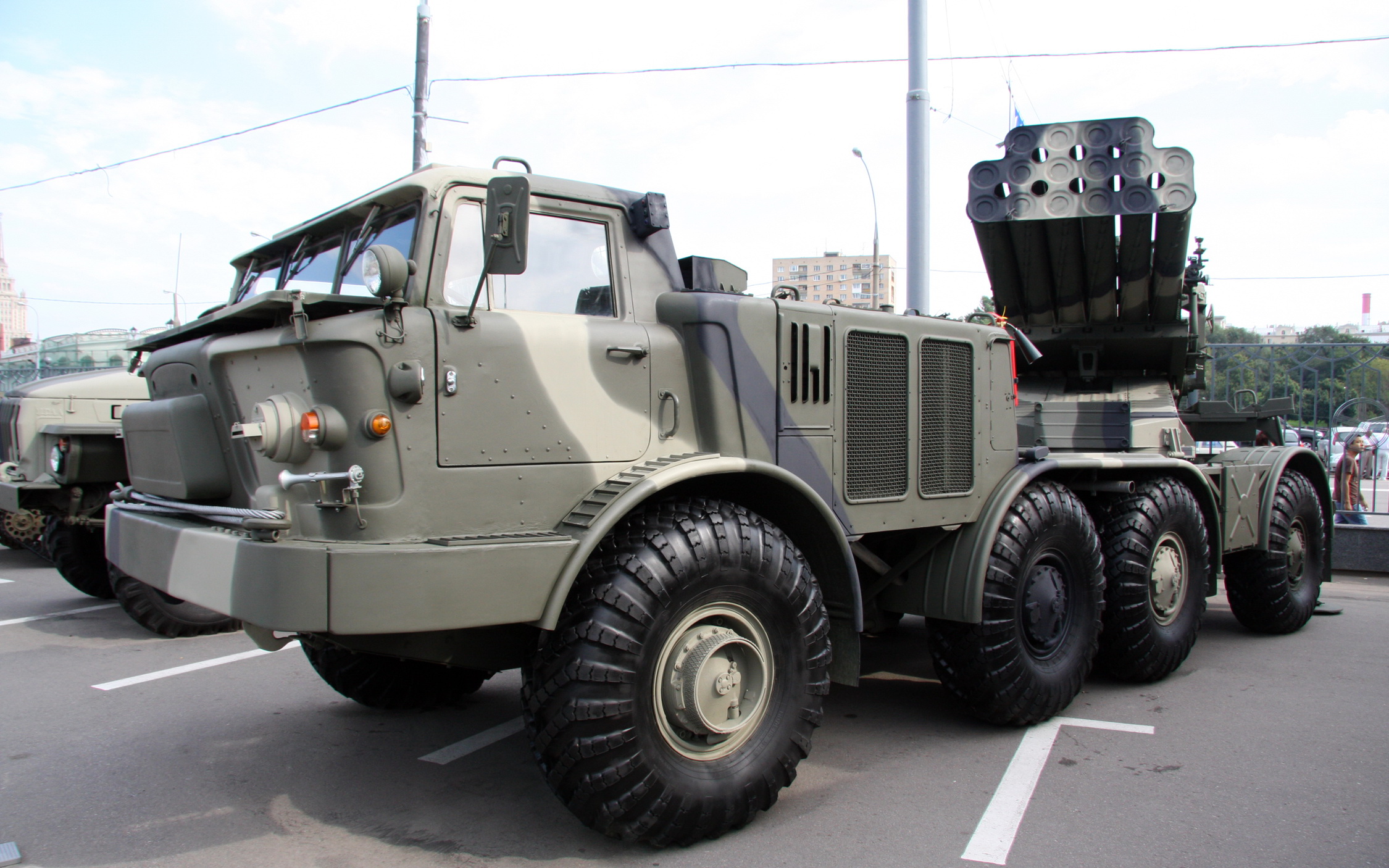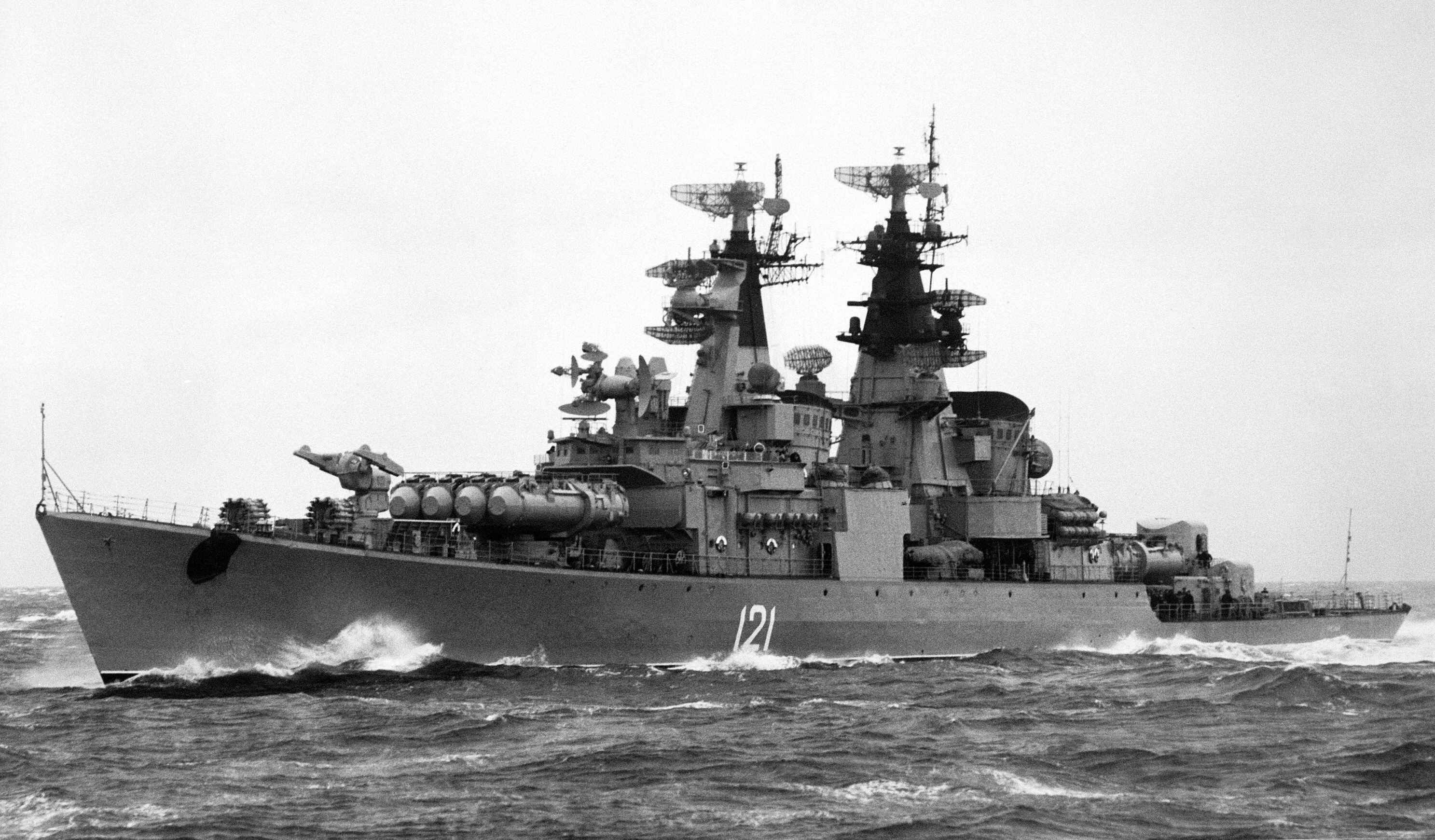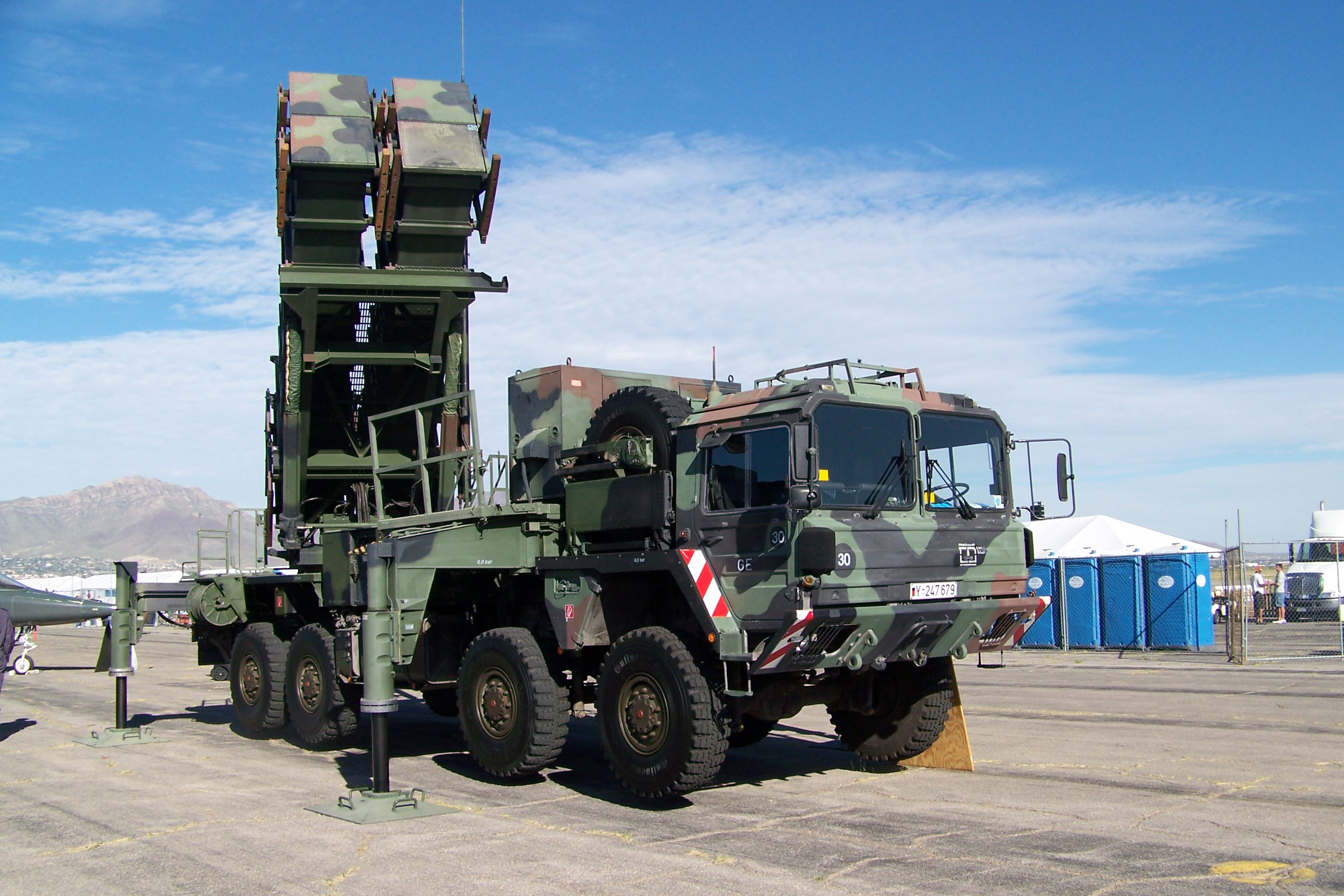|
ZIL-135
The ZIL-135 is a large, eight-wheeled military transport and self-propelled artillery truck produced during the Cold War by the Soviet Union starting in 1959. Its purpose was to carry and launch an artillery missile, specifically a FROG-7, from surface-to-surface. The ZIL-135 was widely exported to other communist countries, most notably North Korea, where it is a common sight in films and military marches. It also served as the TEL for the BM-27 Uragan artillery rocket system. This vehicle has two gasoline engines that power its 20 tonnes to a maximum speed of 65 kilometers per hour. One engine drives the four wheels on the left of the truck, while the other engine drives the four wheels on the right. The ZIL-135 has eight wheel drive, but only the front and rear axles are used for steering. It has a maximum cruising range of 500 kilometers. The cab of the ZIL-135 is NBC protected, allowing the rockets to be fired without exposing the crew to possible contaminants.''Red Steel: ... [...More Info...] [...Related Items...] OR: [Wikipedia] [Google] [Baidu] |
Bryansk Automobile Plant
Bryansk Automobile Plant (BAZ, russian: Брянский автомоби́льный заво́д, БАЗ, Bryansky Avtomobilny Zavod) is a Russian manufacturer of military vehicles based in Bryansk, Russia. It was established in 1958 as a subsidiary of ZiL. It is one of the leading Russian military equipment manufacturers. It also produces off-road tractors and chassis with carrying capacity from 14 to 40 tons. Since 2015 it is part of the Almaz-Antey holding. History Bryansk Automobile Plant was founded 4 June 1958 as a branch of the Moscow factory ZIL for the manufacture of components: driving axles, barrels, boxes handout, suspension and other components for automobiles ZIL-131. The basis for the creation of new business was the manufacture tractor Bizhytskoho steel plant Already in 1959 from Moscow factory was moved production of vehicles for the army, and in 1960 on the base created a special closed design bureau and independent production. In 1961 the first develo ... [...More Info...] [...Related Items...] OR: [Wikipedia] [Google] [Baidu] |
BM-27 Uragan
The BM-27 Uragan (russian: БМ-27 Ураган, lit=Hurricane; GRAU index 9P140) is a self-propelled 220 mm multiple rocket launcher designed in the Soviet Union. The system began its service with the Soviet Army in the late 1970s, and was its first modern spin and fin stabilized heavy multiple rocket launcher. Description The BM-27 Uragan is capable of launching 220 mm rockets from 16 launch tubes mounted on the rear of a ZIL-135 8×8 chassis. This vehicle is extremely similar to that used in the FROG-7 free flight rocket system. It has two gasoline engines that power its 20 tonnes to a maximum speed of 65 kilometers per hour. One engine drives the four wheels on the left of the truck, while the other engine drives the four wheels on the right. The ZIL-135 has eight wheel drive, but only the front and rear axles are used for steering. It has a maximum cruising range of 500 kilometers. The cab of the ZIL-135 is NBC protected, allowing the rockets to be fired without ... [...More Info...] [...Related Items...] OR: [Wikipedia] [Google] [Baidu] |
9K52 Luna-M
The 9K52 ''Luna-M'' (russian: Луна; en, moon, NATO reporting name FROG-7) is a Soviet short-range artillery rocket system which fires unguided and spin-stabilized 9M21 rockets. It was originally developed in the 1960s to provide divisional artillery support using tactical nuclear weapons but gradually modified for conventional use. The 9K52 was eventually succeeded by the OTR-21 Tochka. Description Originally called the 3R-11 and 9R11, the 9M21 is a solid fuel rocket with four off-angle vernier chambers immediately behind the warhead section. When the main engine section ignites, the verniers activate to start spinning the rocket to improve stability and accuracy. At range, the 9M21 has a nominal CEP ( circular error probable) of 400 meters.Soviet/Russian Armor and Artillery Design Practices: 1945-1995. (1995). United States: Marine Corps Intelligence Activity. V-57Soviet/Russian Armor and Artillery Design Practices: 1945-1995. V-58 Western intelligence estimated th ... [...More Info...] [...Related Items...] OR: [Wikipedia] [Google] [Baidu] |
SS-N-3 Shaddock
The P-5 ''"Pyatyorka"'' (russian: П-5 «Пятёрка»; "Pyatyorka", "fiver" in English), also known by the NATO codename SS-N-3C Shaddock, is a Cold War era turbojet-powered cruise missile of the Soviet Union, designed by the Chelomey design bureau. The missile entered service in 1959. ''Pyatyorka'' is a common name for the missile as the "digit 5", corresponding to the R-7 Semyorka, the digit 7. The basic version of the missile was an inertially-guided submarine-launched cruise missile to threaten the US coast. The missile could be armed with either a 1000 kg high explosive or a 200 or 350 kt nuclear warhead. It had a speed of about 0.9 Mach, range of 500 km and CEP of about 3000 m. The later variant had a range of possibly up to 1000 km. The first missiles were installed in Project 644, Whiskey Twin Cylinder and Project 665, Whiskey Long Bin submarines. Versions of P-5 were later developed equipped with radar homing to be used as anti-ship missile ... [...More Info...] [...Related Items...] OR: [Wikipedia] [Google] [Baidu] |
Mobile Launcher Vehicle
In the military, vehicles such as trucks or tractor units can be used to transport or launch missiles (rockets with warheads), essentially a form of rocket artillery. History The missile vehicle may be a self-propelled unit or the missile holder/launcher may be on a trailer towed by a prime mover. They are used in the military forces of a number of countries in the world. Long missiles are commonly transported parallel to the ground on these vehicles, but elevated into an inclined or vertical position for launching. Missile vehicles include transporter erector launchers (TEL) and multiple rocket launchers (MRL) such as the Patriot missile system. Single or dual missile vehicles often transport their missiles uncovered. The missile batteries of multiple rocket launchers often hold their missiles inside tubular or rectangular canisters for each missile, from which the missiles or rockets can be launched (or fired, in other words). Many missile trucks use pneumatic (air-fi ... [...More Info...] [...Related Items...] OR: [Wikipedia] [Google] [Baidu] |
Military Trucks Of The Soviet Union
A military, also known collectively as armed forces, is a heavily armed, highly organized force primarily intended for warfare. It is typically authorized and maintained by a sovereign state, with its members identifiable by their distinct military uniform. It may consist of one or more military branches such as an army, navy, air force, space force, marines, or coast guard. The main task of the military is usually defined as defence of the state and its interests against external armed threats. In broad usage, the terms ''armed forces'' and ''military'' are often treated as synonymous, although in technical usage a distinction is sometimes made in which a country's armed forces may include both its military and other paramilitary forces. There are various forms of irregular military forces, not belonging to a recognized state; though they share many attributes with regular military forces, they are less often referred to as simply ''military''. A nation's military may f ... [...More Info...] [...Related Items...] OR: [Wikipedia] [Google] [Baidu] |
ZiL Vehicles
OJSC AMO ZiL, known fully as the Public Joint-Stock Company – Likhachov Plant () and more commonly called ZiL (, was a major Russian automobile, truck, military vehicle, and heavy equipment manufacturer that was based in Moscow, Russia. The last ZiL vehicle was assembled in 2012. The company continues to exist only as real-estate development site, on which a new urban district will be built by the LSR Group construction company. History The factory was founded on 2 August 1916 as the Moscow Automotive Society or AMO (). The factory was completed in 1917, just before the Revolution, and was built south of Moscow near Moscow River in Tjufeleva grove. It was a modern building with the latest in American equipment and was designed to employ 6,000 workers. The plans were to produce Fiat F-15 1.5-ton trucks under license. Because of the October Revolution and the subsequent Russian Civil War, it took until 1 November 1924 to produce the first vehicle which was shown at a parade ... [...More Info...] [...Related Items...] OR: [Wikipedia] [Google] [Baidu] |
Wheeled Self-propelled Rocket Launchers
A wheel is a circular component that is intended to rotate on an axle bearing. The wheel is one of the key components of the wheel and axle which is one of the six simple machines. Wheels, in conjunction with axles, allow heavy objects to be moved easily facilitating movement or transportation while supporting a load, or performing labor in machines. Wheels are also used for other purposes, such as a ship's wheel, steering wheel, potter's wheel, and flywheel. Common examples are found in transport applications. A wheel reduces friction by facilitating motion by rolling together with the use of axles. In order for wheels to rotate, a moment needs to be applied to the wheel about its axis, either by way of gravity or by the application of another external force or torque. Using the wheel, Sumerians invented a device that spins clay as a potter shapes it into the desired object. Terminology The English word ''wheel'' comes from the Old English word , from Proto-Germanic , from ... [...More Info...] [...Related Items...] OR: [Wikipedia] [Google] [Baidu] |
Land Train
Land, also known as dry land, ground, or earth, is the solid terrestrial surface of the planet Earth that is not submerged by the ocean or other bodies of water. It makes up 29% of Earth's surface and includes the continents and various islands. Earth's land surface is almost entirely covered by regolith, a layer of rock, soil, and minerals that forms the outer part of the crust. Land plays important roles in Earth's climate system and is involved in the carbon cycle, nitrogen cycle, and water cycle. One-third of land is covered in trees, 15% is used for crops, and 10% is covered in permanent snow and glaciers. Land terrain varies greatly and consists of mountains, deserts, plains, plateaus, glaciers, and other landforms. In physical geology, the land is divided into two major categories: mountain ranges and relatively flat interiors called cratons. Both are formed over millions of years through plate tectonics. A major part of Earth's water cycle, streams shape the landscape ... [...More Info...] [...Related Items...] OR: [Wikipedia] [Google] [Baidu] |
NBC (weapon)
A weapon of mass destruction (WMD) is a chemical, biological, radiological, nuclear, or any other weapon that can kill and bring significant harm to numerous individuals or cause great damage to artificial structures (e.g., buildings), natural structures (e.g., mountains), or the biosphere. The scope and usage of the term has evolved and been disputed, often signifying more politically than technically. Originally coined in reference to aerial bombing with chemical explosives during World War II, it has later come to refer to large-scale weaponry of warfare-related technologies, such as chemical, biological, radiological, or nuclear warfare. Early uses of this term The first use of the term "weapon of mass destruction" on record is by Cosmo Gordon Lang, Archbishop of Canterbury, in 1937 in reference to the aerial bombing of Guernica, Spain: At the time, nuclear weapons had not been developed. Japan conducted research on biological weapons (see Unit 731), and chemic ... [...More Info...] [...Related Items...] OR: [Wikipedia] [Google] [Baidu] |
Transporter Erector Launcher Of Redut Coastal Missile System At Park Patriot 01
Transporter may refer to: * Transporter (vehicles), types of vehicles designed to transport items * Transporter wagon, a railway car designed to carry another railway car * Volkswagen Transporter, a model of van * Transporter bridge, a bridge which carries cars across a river in a suspended gondola * Middlesbrough Transporter Bridge, the transporter bridge in Middlesbrough, England Film and television * ''The Transporter'' (1950 film), an Italian film directed by Giorgio Simonelli * Transporter (''Star Trek''), a fictional type of teleportation device in ''Star Trek'' * ''Transporter'' (franchise), a series of action films starring Jason Statham ** ''The Transporter'', a 2002 action film starring Jason Statham ** ''Transporter 2'', a 2005 action film starring Jason Statham ** ''Transporter 3'', a 2008 action film starring Jason Statham ** ''The Transporter Refueled'', a 2015 action film reboot of the franchise * '' Transporter: The Series'', a 2012 TV series starring Chris Va ... [...More Info...] [...Related Items...] OR: [Wikipedia] [Google] [Baidu] |








